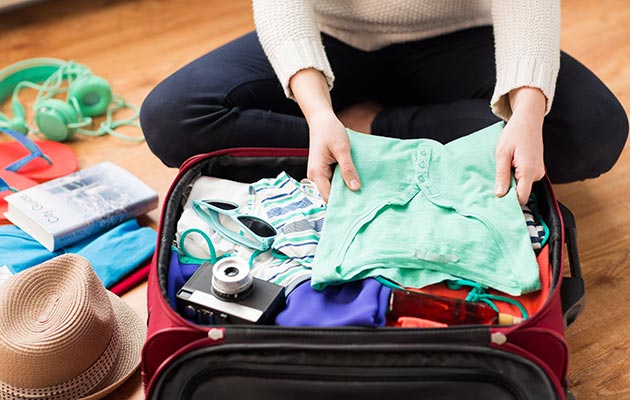
Next month I’m heading over to the UK for a two-week tour of England where I’ll be staying in a different accommodation almost every night. While super exciting, packing for such a trip can be a nightmare. I don’t need to lug my large suitcase containing everything for my 10 day trip into a hotel where I’m only staying one night. So what to do? Read on to learn how I’ve mastered the art of packing and the dreaded road trip packing!
Okay, so that deals with your regular packing needs. For a road trip where you’ll be staying in multiple hotels you’ll need one large suitcase and one overnight duffle or carry on size case.
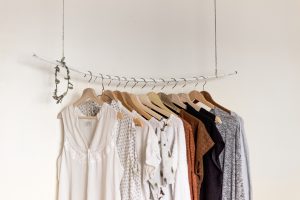
The answer is …. Sort of.
I don’t necessarily wear the EXACT SAME THING EVERY DAY, but yes, I have about 4-5 outfits that I wear ALL THE TIME.
Why do I do that?
As a business owner, mom and CFO and COO (and housekeeper and launderer …) of our household, I’ve got A LOT TO DO. So the last thing I want to waste my energy on is figuring out what the heck to wear.
So, my general formula is:
And that’s about it. There’s no magic formula. There’s no exact number of items. There are no rules.
Here’s a few things to try:
Pare it down
When you are at a stage in life where you’ve just got TOO MUCH TO DO, then DO LESS. Channel your inner Steve Jobs (black tee and jeans!), make one less decision, and kick your morning off right.
As a residential professional organizer, I visit lots of homes. One household system that is quick to fall apart and overwhelm a person is LAUNDRY.
I have strong opinions on laundry:
• dark and light clothing should be separated (my children do not all agree)
• “laundry” is not done until it is all put away
You don’t have to share those views, but I see on a weekly basis how the “putting away” is where the system breaks down. Most of us are pretty good starting the laundry process. There is an obvious and inevitable external motivation to wash clothes when one runs out of clean socks or underwear. Many people are also decent at shifting the wet clothes over to the dryer. The widespread access to timers on our phones has made this step particularly easy for even the “follow-through-challenged.”
I see “laundry overwhelm” during the next 2 points in the system:
1) clean but not yet folded clothes that remain clean…until they get mixed with dirty clothes or buried under other stuff
2) folded clothes in baskets — when not returned to dresser drawers or closets they clog bedrooms and hallways and hold laundry baskets hostage creating a problem for dirty clothes who remain “homeless”
If we focus on these 2 connected steps along the process: 1) folding and 2) putting away and employ task batching, the process goes smoother.
Task batching is a way to manage time and perform tasks in sets where the same mental effort and physical energy is used to maximize productivity and streamline a process.
Even if laundry is not the most stressful task, any project you can simplify will free up your mind for the heavy lifting of life. If you’re a procrastinator, my suggestion to task batch your folding and put away steps is good news! It decreases the distance between start and finish and builds in lots of manageable size “loads.” More, but smaller tasks to quickly complete, offer the satisfaction of a job well done!
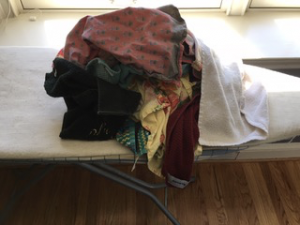
Take this example of table linens – out of the dryer and onto a folding surface.
Task Batched Folding Steps would look like this:
• Sort clean laundry into categories: if you mix loads from a whole household, your first sort job will be by person, then by category of clothing (socks, underwear, shirts that fold, shirts that hang, bottoms, work out clothing, pajamas…etc).
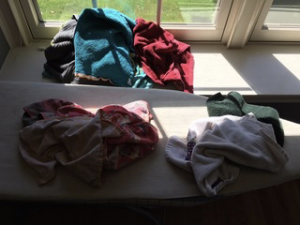
Step 1: sort into categories: this load broke down into hand towels, dish towels and cloth napkins.
• Prep each category so it’s ready to be folded (right any clothes that are inside out or button collars).
• Fold each category separately – meaning one category at a time – preferably on a clean and flat surface.
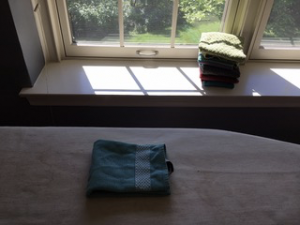
• Do all of your folding at once.
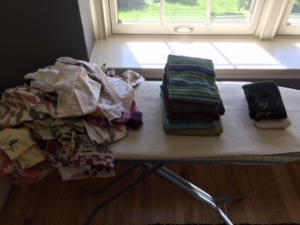
Step 2: fold each mini pile as its own category.
Our cloth napkins need to be ironed so they’ll stay on the ironing board.
The other 2 folded piles will go into their appropriate drawers in the kitchen.
Will task batching your folding process solve all of your laundry dilemma’s? No — but folding by category allows you to delegate small pieces of the project to even the youngest helpers and lets others take pride in the smooth running of the household if you’re lucky enough to live with people who will “volunteer” or as in our household, be volunteered to help 🙂
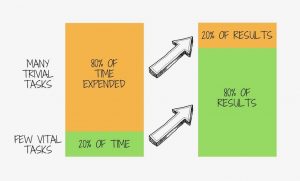 Have you ever gotten to the end of your day wondering what (if anything) of value you actually accomplished? If so, it may be time to pull out the 80/20 Rule!
Have you ever gotten to the end of your day wondering what (if anything) of value you actually accomplished? If so, it may be time to pull out the 80/20 Rule!
Professional organizers often apply the 80/20 Rule (a.k.a., the Pareto Principle or the Law of the Vital Few) to decluttering. For example, in a closet, determine the 20% of clothes you wear 80% of the time, purge the 80% of clothes you seldom or never use, and – voila! – you have space for clothes more like your favorite few.
The principle also applies to time. Most of us accomplish 80% of our best work in just 20% of our time, and fritter away 80% of our time doing…what? The key to really accomplishing our goals, to really making an impact, is to focus on the 20% of things we are really good at.
Determining our best 20% when it comes to clothes is pretty straightforward: pull everything out of the closet and start sorting: things I love (or not), things that fit (or not), things that make me look great (or not), etc.
But how do we determine our best 20% when it comes to work? Claire Diaz-Ortiz, in the book Design Your Day, suggests this similar pull-out-and-sort activity to find out:
First, get two pieces of paper. At the top of one write “Big Wins” and on the other write “Activities.”
On the “Big Wins” paper, list things that you’ve done in the past few years, personally or professionally, that have brought you the greatest joy, that have made you feel most alive, that have made you feel like you were in the sweetest of sweet spots. These could be things that happened just once, or continuing things.
On the “Activities” paper, list absolutely everything you do on a regular basis – fun or not fun, significant or not significant, necessary or unnecessary, whatever. Then sort these items into three categories: Things Only I Can Do, Things Someone Else Can Do, and Things I Should Stop Doing. (It might help to rewrite your activities on a fresh piece of paper with three columns headed with these categories.)
Next, cross-check. Things that appear on both your “Big Wins” list and your “Things Only I Can Do” list are your best 20%!
Now, set priorities:
As Diaz-Ortiz says, “ultimately, this activity is a mind-opening way to see where your time and work is really moving the needle and where you’re just running on the hamster wheel to stay busy.”
Let 2018 be the year where you focus on the few vital tasks that best get you to where you want to be.
80/20 your 2018!
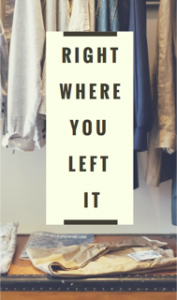 If being organized is not how you were raised but you’ve started to become more orderly, you may already know: it takes time getting used to “being organized.”
If being organized is not how you were raised but you’ve started to become more orderly, you may already know: it takes time getting used to “being organized.”
I learned this with a new client: Kim (not her real name) has struggled all her life to maintain a neat space. Her efforts go in waves and she has managed to live a really rich and creative life — but it hasn’t been easy. She’s lost a few things along the way. Paid her share of late fees for bills and penalties for misplaced parking tickets. And wasted time rewashing clothes after the dirty commingled with the clean.
When she was ready to stop this chaos…she called in a professional organizer.
She had 3 areas to organize:
• her wardrobe and bedroom
• her living room – including a desk area
• her hallway which had become an over-crowded storage space
We started in her bedroom because the mess was affecting her sleep. After 3 working sessions we had sorted through all of her clothes, cleared every surface (including the floor) of anything that didn’t belong, rearranged her dresser drawers and closet with zones for each type of clothing she needed in her life.
Moving on to the living room, Kim sheepishly told me a “funny” story about her missing slippers. The one constant in Kim’s life had been lots of weekends away to cabins with friends. In preparing to pack for one such weekend, she described how she had scoured her apartment looking for her slippers.
She checked ALL of her usual spots: under the coffee table, in the bathroom, kicked under the hallway table, in a pile behind the couch, tucked under her bed, tossed into a corner by her cat…she couldn’t find them anywhere.
She left for her weekend sans slippers in a bummed mood.
As soon as she got on the road to the cabin, it hit her. She couldn’t help but laugh out loud. Her slippers were right where we had left them — in their new home. They were in the bottom “bay” of the hanging shoe organizer we had installed in her closet.
It was a funny lesson to us both, that getting organized takes some getting used to! The motto of Kim’s story is: It’s easy to find what you need when you need it…when it is right where you left it.
Over the past 3 years, I’ve called three different NAPO colleagues to help me with my own organizing projects. Each time it was a fantastic experience. Not only did I get stuff done, I really got an appreciation for what it feels like to be the client AND as a result, I am a better Productivity and Organizing Consultant!
I hired professional organizers (or PO’s) to help me:
Here are some key takeaways from these sessions:
I was thrilled by what I got done: cleaned out an overwhelming amount of stuff so I could close down my mother’s apartment, became very tech-comfortable, and am feeling stylish and well-dressed like never before. The gratitude I feel towards these organizers is immense.
I close by urging all PO’s who have never hired another Professional Organizer to do so. Everyone can improve their productivity and up their level of being organized. And you’ll have much greater understanding and empathy for your clients!